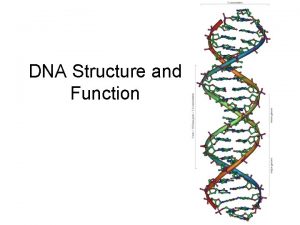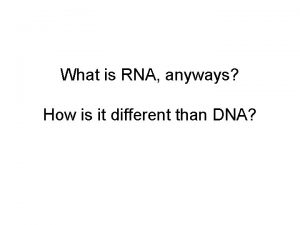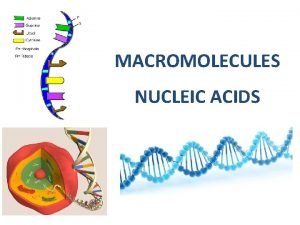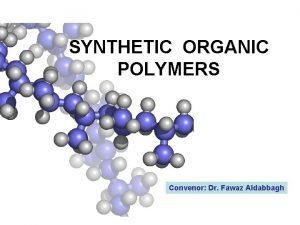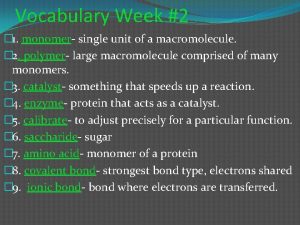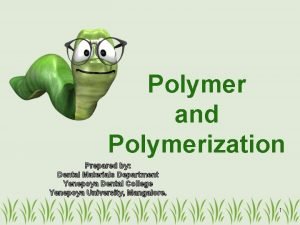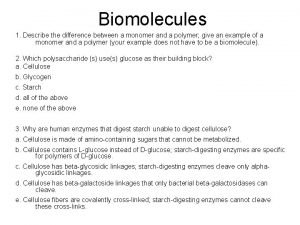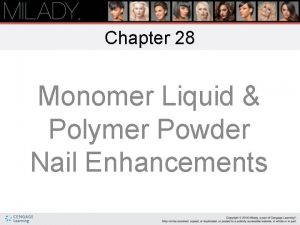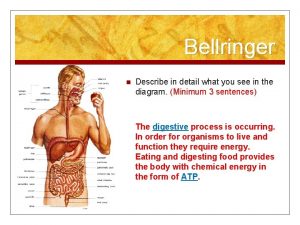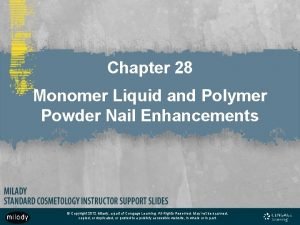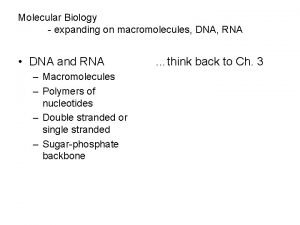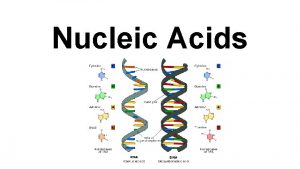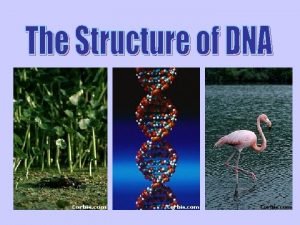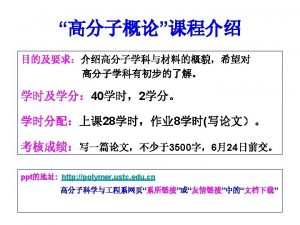NUCLEIC ACIDS Polymer Nucleic Acids Monomer Nucleotide RNA











- Slides: 11

NUCLEIC ACIDS

Polymer- Nucleic Acids Monomer- Nucleotide RNA- Ribonucleic Acid DNA- Deoxyribonucleic Acid Tells amino acids what to do and what to build 2 TYPES OF NUCLEIC ACIDS

Deoxyribonucleic Acid Five carbon sugar Phosphate (pentose-Ribose) 1 -3 phosphates, during phosphorylation, 2 are lost 1 of 4 nitrogenous bases Adenine Guanine Cytosine Thymine DNA


There are Four nitrogenous bases They act as bases because the nitrogen atoms attract the H+ ions causing the solution to act like a base Purines: Large six sided sugars fused to a five ring sugar (Adenine and Guanine) Pyrimidine: Six membered sugar including Cytosine, Thymine (DNA) and Uracil (RNA) NITROGENOUS BASES


Monomers become polymers through a phosphodiester bond, where the phosphate connects the sugars of the nucleotides This linkage creates a pattern with a 5’ and a 3’ end based on the carbon they are attached to When we discuss the genetic code And DNA sequence we say either a 5’ or 3’ end such as 5’ ATTGAC 3’ 3’ TAACTG 5’ DEHYDRATION SYNTHESIS

DNA consists of two strands that are antiparallel (opposite) Backbones are on the outside and the nitrogenous bases are connected in the middle by hydrogen bonds Weak bonds allow for the strands to be easily separated for protein synthesis Complimentary base pairs A-T and C-G DOUBLE HELIX

Fig. 5 -28 5' end 3' end Sugar-phosphate backbones Base pair (joined by hydrogen bonding) Old strands Nucleotide about to be added to a new strand 3' end 5' end New strands 5' end 3' end

RNA is a single stranded nucleic acid RNA can base pair with itself allowing them to take a 3 -D structure Comes in different forms Transfer RNA- brings amino acids to ribosome Messenger RNA- transcribes DNA into RNA

 Polymer structure of nucleic acids
Polymer structure of nucleic acids Nucleotide in rna
Nucleotide in rna Building block of nucleic acids
Building block of nucleic acids Nucleic acid monomer
Nucleic acid monomer Polymerization of monomers
Polymerization of monomers Carbohydrates elements present
Carbohydrates elements present Polymers in dental materials
Polymers in dental materials Glycogen vs starch vs cellulose
Glycogen vs starch vs cellulose When using monomer liquid and polymer powder you
When using monomer liquid and polymer powder you Monomer-polymer matchup
Monomer-polymer matchup Monomer liquid and polymer powder nail enhancements are
Monomer liquid and polymer powder nail enhancements are Nucleic acid polymer
Nucleic acid polymer
